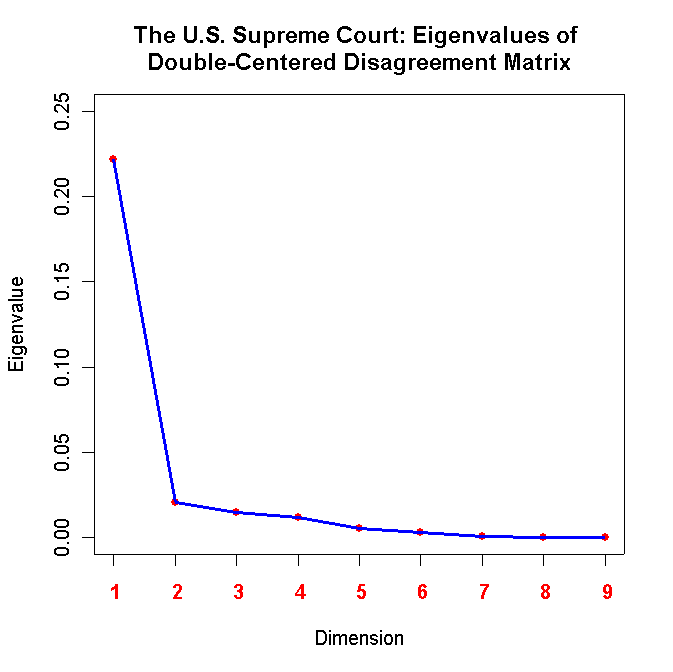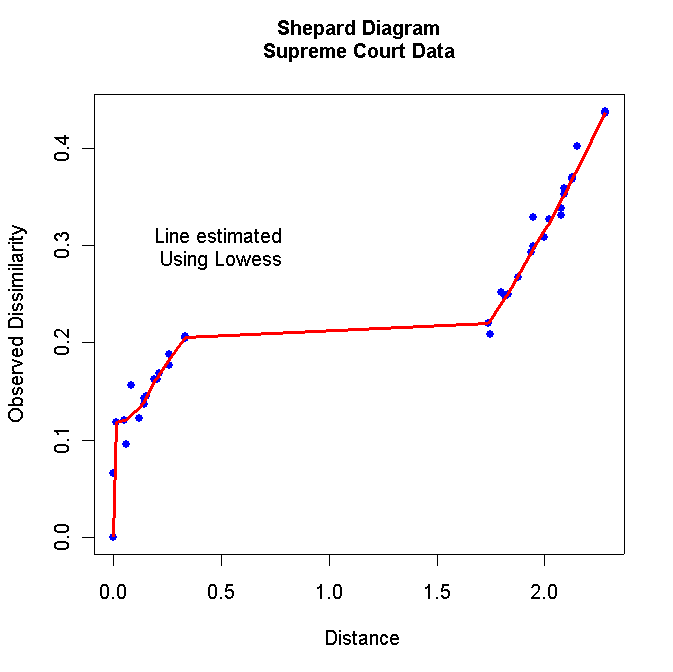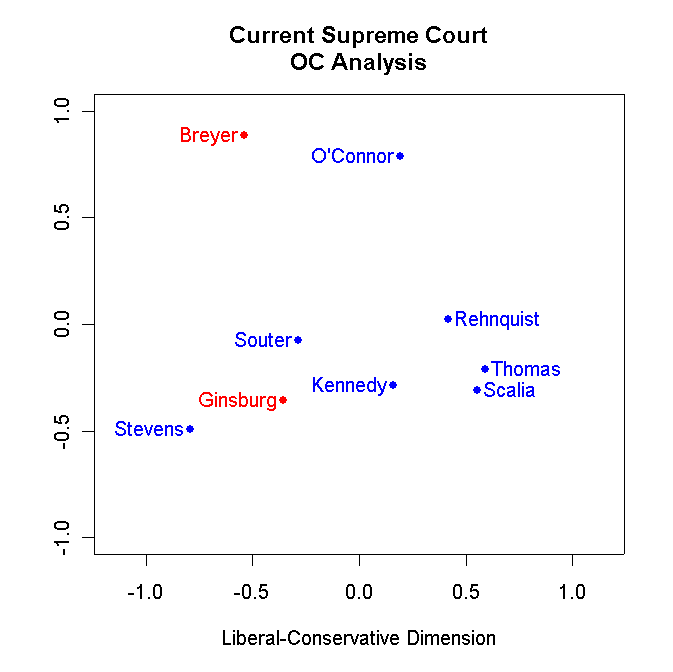LEGACY CONTENT.
If you are looking for Voteview.com, PLEASE CLICK HEREThis site is an archived version of Voteview.com archived from University of Georgia on
May 23, 2017. This point-in-time capture includes all files publicly linked on Voteview.com at that time. We provide access to this content as a service to ensure that past users of Voteview.com have access to historical files. This content will remain online until at least
January 1st, 2018. UCLA provides no warranty or guarantee of access to these files.
The Unidimensional
Supreme Court
10 July 2003
In a recent piece in the Proceedings of the National Academy of Sciences
Lawrence Sirovich analyzed the voting patterns of the current Supreme Court ("A Pattern
Analysis of the Second Rehnquist U.S. Supreme Court." PNAS, 100 (24 June
2003):7432-7437). This piece received a great deal of publicity in the popular
science press. The purpose of this short comment is to show that Sirovich's findings
are consistent with current work on the Court by Political Scientists such as
Bernard Grofman,
Kevin Quinn and
Andrew Martin, and
Joshua Clinton,
Simon Jackman, and Douglas Rivers.
This recent highly innovative research by
Quinn and
Martin
and CJR in turn
builds upon path-breaking work by Glendon Schubert (The Judicial Mind, 1965,
Evanston: Northwestern University Press), David Rohde and Harold Spaeth (Supreme
Court Decision Making, 1976, San Francisco: W. H. Freeman), Jeffrey Segal and
Harold Spaeth (The Supreme Court and the Attitudinal Model, 1993,
Cambridge: Cambridge University Press), Lee Epstein and Jack Knight (The Choices
Justices Make, 1998, Washington, DC: CQ Press), Bernard Grofman and Timothy
Brazill ("Identifying the Median Justice on the Supreme Court Through
Multidimensional Scaling: Analysis of 'Natural Courts' 1953-1991." Public
Choice, 112:55-79, 2002), to name just a few. An excellent
summary of the literature can be found in
"The Dimensions of Supreme Court
Decision Making: Again Revisiting The Judicial Mind" by
Kevin Quinn and Andrew Martin.
Sirovich's approach was to perform
Singular Value Decomposition (SVD) on the
matrix of Supreme Court "roll calls" -- 468 votes cast during the 8 year period
1995-2002. In
multidimensional scaling work the normal practice is to discard
the unanimous votes because they contain no information about
the ideal points of the voters unless strong assumptions are made about the proposal
process. Sirovich included the 220 unanimous votes in his analysis. Consequently, when
he performed a SVD on the 9 by 468 matrix the first singular vector was, in effect,
(1/3, 1/3, 1/3, 1/3, 1/3, 1/3, 1/3, 1/3, 1/3) -- that is, the first singular vector
picked up a "unanimous" dimension with all the justices almost at the same point
(see Table 3, p. 7434). His second singular vector was:
Stevens -0.445911
Ginsburg -0.367567
Breyer -0.327401
Souter -0.3127
O'Connor 0.104212
Kennedy 0.174192
Rehnquist 0.304502
Scalia 0.403145
Thomas 0.405752
This is clearly a liberal-conservative dimension that closely matches the standard
journalistic description of the Court.
In Table 2 Sirovich shows the Joint Probability for Disagreement for the Court. This
table is reproduced below:
Breyer 0.00000 0.11966 0.25000 0.20940 0.29915 0.35256 0.11752 0.16239 0.35897
Ginsburg 0.11966 0.00000 0.26790 0.25214 0.30769 0.36966 0.09615 0.14530 0.36752
Kennedy 0.25000 0.26709 0.00000 0.15598 0.12179 0.18803 0.24786 0.32692 0.17735
OConnor 0.20940 0.25214 0.15598 0.00000 0.16239 0.20726 0.22009 0.32906 0.20513
Rehnquist 0.29915 0.30769 0.12179 0.16239 0.00000 0.14316 0.29274 0.40171 0.13675
Scalia 0.35256 0.36966 0.18803 0.20726 0.14316 0.00000 0.33761 0.43803 0.06624
Souter 0.11752 0.09615 0.24790 0.22009 0.29274 0.33761 0.00000 0.16880 0.33120
Stevens 0.16239 0.14530 0.32692 0.32906 0.40171 0.43803 0.16880 0.00000 0.43590
Thomas 0.35897 0.36752 0.17735 0.20513 0.13675 0.06624 0.33120 0.43590 0.00000
Note that this table does not exactly match Sirovich's Table 2 in that his table has
rounding errors. For example, the disagreement probability of the pair (O'Connor, Kennedy)
is shown as 0.156 and the disagreement probability of the pair (Kennedy, O'Connor) is shown
as 0.15598. These discrepancies are only at the 4th or 5th decimal place (the R software
often produces this type of discrepancy!) so I simply chose one of the values to make the
matrix symmetric. This should have absolutely no effect upon my analysis below.
The above matrix is known in Psychometrics as a dissimilarity matrix and
the properties of this type of data have been studied for almost 100 years (see
The Past and Future of Ideal Point Estimation for
an overview). Dissimilarities data can be treated as squared Euclidean distances
and double-centered. This operation removes the
squared terms and leaves only the cross-product matrix. This matrix is symmetric and can
subjected to
standard eigenvalue-eigenvector decomposition.
A Skree plot of the eigenvalues is a good method of determining the dimensionality of a
voting matrix (although it should never be used as the only method -- it should
always be used in conjunction with standard fit statistics produced by a spatial
voting model!). Below is a graph of the eigenvalues of the double-centered disagreement
matrix:

This pattern strongly suggests that there is only one dimension underlying
the matrix. Indeed, below is the first eigenvector:
Stevens -0.4981644
Ginsburg -0.3376050
Breyer -0.2985069
Souter -0.2694862
O'Connor 0.1074960
Kennedy 0.1602323
Rehnquist 0.3024991
Scalia 0.4167577
Thomas 0.4167775
this ordering exactly matches the 2nd singular vector shown above.
Further evidence of unidimensionality comes from a non-metric multidimensional
scaling analysis using KYST. Below is the
one dimensional configuration from KYST:
Stevens -1.248
Ginsburg -1.100
Breyer -1.054
Souter -1.041
O'Connor 0.700
Kennedy 0.776
Rehnquist 0.899
Scalia 1.034
Thomas 1.034
This ordering matches the two above.
The STRESS value was 0.0098 indicating nearly perfect unidimensionality. Below
is the Shepard Diagram for the scaling:

Further evidence of unidimensionality of the current Court is provided by
an application of Optimal Classification Analysis (OC)
to the voting data for the current Court through 2001. In one dimension OC produces
a rank ordering and in two or more dimensions is provides point estimates (these are
really polytopes -- for a detailed explanation see):
The total number of non-unanimous votes was 293 (the total number of votes in the
sample was 512) and in one dimension the correct
classification was 93.1% with an APRE of .755. OC
produces the following rank ordering:
1 STEVENS 23 291 0.921 1.000
2 BREYER 30 290 0.897 2.000
3 GINSBURG 18 291 0.938 3.000
4 SOUTER 19 293 0.935 4.000
5 KENNEDY 13 293 0.956 5.000
6 OCONNOR 29 290 0.900 6.000
7 REHNQUIS 20 292 0.932 7.000
8 SCALIA 13 292 0.955 8.000
9 THOMAS 16 292 0.945 9.000
In the ordering above,
the number just to the right of the Justice's
name is the classification error and the number to the right of that is the
total number of
votes cast by the member. For example, placing Justice Stevens at rank
1 resulted in 23 classification errors out
of a total of 291 votes cast. The proportion
correct is 218/222 = .921 (which is shown just to the left of the rank).
The rank-ordering from OC reverses the positions of Kennedy and O'Connor and
Breyer and Ginsburg compared with the configurations above.
In two dimensions the correct classification was 97.0% with an APRE of .893. Below
is a plot of the two dimensional OC configuration (Justices in
Blue are Republican appointees and Justices
in Red are Democratic appointees):

The OC results suggest the possible presence of a weak second dimension. However,
this is probably simply noise fitting. Note that the second dimension is simply a
Breyer-O'Connor dimension. Breyer and O'Connor are the two worst fitting
(89.7% and 90.0% respectively) justices in one dimension. In two dimensions
the fits for Breyer and O'Connor jump to 99.0% and 98.6% respectively whereas the
increases in fit for the other justices only increase from 1 to 4 percentage
points.
The bottom line is that the current Court is basically unidimensional.
Again, for a thorough in-depth analysis of the Supreme Court over the 1937 to 2000 period
see the innovative markov-chain monte-carlo (MCMC) work of
Kevin Quinn and
Andrew Martin. The 1953-1991
period is analyzed by
Bernard Grofman and
Timothy Brazill who find basic unidimensional voting, and
the 1994-97
period is used by Joshua Clinton,
Simon Jackman, and Douglas Rivers to illustrate their IDEAL program in an one
dimensional analysis.
 VOTEVIEW Blog
VOTEVIEW Blog
 NOMINATE Data, Roll Call Data, and Software
NOMINATE Data, Roll Call Data, and Software
 Course Web Pages: University of Georgia (2010 - )
Course Web Pages: University of Georgia (2010 - )
 Course Web Pages: UC San Diego (2004 - 2010)
Course Web Pages: UC San Diego (2004 - 2010)
 University of San Diego Law School (2005)
University of San Diego Law School (2005)
 Course Web Pages: University of Houston (2000 - 2005)
Course Web Pages: University of Houston (2000 - 2005)
 Course Web Pages: Carnegie-Mellon University (1997 - 2000)
Course Web Pages: Carnegie-Mellon University (1997 - 2000)
 Analyzing Spatial Models of Choice and Judgment with R
Analyzing Spatial Models of Choice and Judgment with R
 Spatial Models of Parliamentary Voting
Spatial Models of Parliamentary Voting
 Recent Working Papers
Recent Working Papers
 Analyses of Recent Politics
Analyses of Recent Politics
 About This Website
About This Website
 K7MOA Log Books: 1960 - 2017
K7MOA Log Books: 1960 - 2017
 Bio of Keith T. Poole
Bio of Keith T. Poole
 Related Links
Related Links


